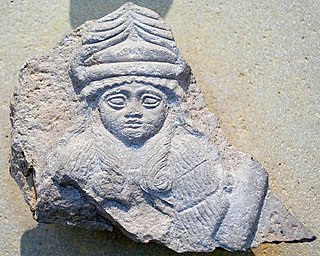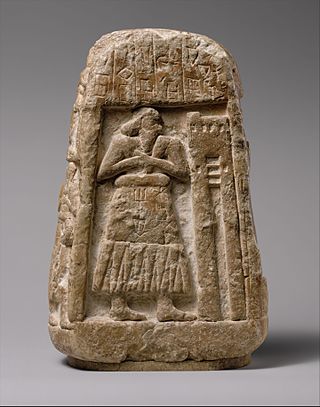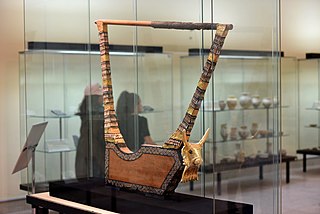Related Research Articles

Ninḫursaĝ sometimes transcribed Ninursag, Ninḫarsag, or Ninḫursaĝa, also known as Damgalnuna or Ninmah, was the ancient Sumerian mother goddess of the mountains, and one of the seven great deities of Sumer. She is known earliest as a nurturing or fertility goddess. Temple hymn sources identify her as the "true and great lady of heaven" and kings of Lagash were "nourished by Ninhursag's milk". She is the tutelary deity to several Sumerian leaders.
Nintinugga was a Mesopotamian goddess associated with medicine and cleansing. She belonged to the local pantheon of Nippur. While she has been compared to other similar goddesses, such as Ninisina and Gula, and in a number of ancient texts they appear to be syncretised with each other or are treated as interchangeable, she was nonetheless a distinct deity in her own right. She was associated with Enlil and Ninlil, and was worshiped in their temples, though houses of worship dedicated only to her are also attested.

Bau, also read Baba or Babu (cuneiform: 𒀭𒁀𒌑 dBa-U2), was a Mesopotamian goddess. The reading of her name is a subject of debate among researchers, though Bau is considered the conventional spelling today. While initially regarded simply as a life-giving deity, in some cases associated with the creation in mankind, over the course of the third and second millennia BCE she also acquired the role of a healing goddess. She could be described as a divine midwife. In art she could be depicted in the company of waterfowl or scorpions.

Ningal was a Mesopotamian goddess regarded as the wife of the moon god, Nanna/Sin. She was particularly closely associated with his main cult centers, Ur and Harran, but they were also worshiped together in other cities of Mesopotamia. She was particularly venerated by the Third Dynasty of Ur and later by kings of Larsa.

Nanshe was a Mesopotamian goddess in various contexts associated with the sea, marshlands, the animals inhabiting these biomes, namely bird and fish, as well as divination, dream interpretation, justice, social welfare, and certain administrative tasks. She was regarded as a daughter of Enki and sister of Ningirsu, while her husband was Nindara, who is otherwise little known. Other deities who belonged to her circle included her daughter Nin-MAR.KI, as well as Hendursaga, Dumuzi-abzu and Shul-utula. In Ur she was incorporated into the circle of Ningal, while in incantations she appears alongside Ningirima or Nammu.

Nisaba was the Mesopotamian goddess of writing and grain. She is one of the oldest Sumerian deities attested in writing, and remained prominent through many periods of Mesopotamian history. She was commonly worshiped by scribes, and numerous Sumerian texts end with the doxology "praise to Nisaba" as a result. She declined after the Old Babylonian period due to the rise of the new scribe god, Nabu, though she did not fully vanish from Mesopotamian religion and attestations from as late as the neo-Babylonian period are known.
Pabilsaĝ was a Mesopotamian god. Not much is known about his role in Mesopotamian religion, though it is known that he could be regarded as a bow-armed warrior deity, as a divine cadastral officer or a judge. He might have also been linked to healing, though this remains disputed. In his astral aspect, first attested in the Old Babylonian period, he was a divine representation of the constellation Sagittarius.
Ningirida was a Mesopotamian goddess regarded as the wife of Ninazu and mother of Ningishzida. Little is known about her character beyond her relation to these two gods.
Aya was a Mesopotamian goddess associated with dawn. Multiple variant names were attributed to her in god lists. She was regarded as the wife of Shamash, the sun god. She was worshiped alongside her husband in Sippar. Multiple royal inscriptions pertaining to this city mention her. She was also associated with the Nadītu community inhabiting it. She is less well attested in the other cult center of Shamash, Larsa, though she was venerated there as well. Additional attestations are available from Uruk, Mari and Assur. Aya was also incorporated into Hurrian religion, and in this context she appears as the wife of Shamash's counterpart Šimige.
Ama-arḫuš was a Mesopotamian goddess associated with compassion and healing or epithet of goddesses designating them as compassionate.
Gatumdug was a Mesopotamian goddess regarded as the tutelary deity of Lagash and closely associated with its kings. She was initially worshiped only in this city and in NINA, but during the reign of Gudea a temple was built for her in Girsu. She appears in a number of literary compositions, including the hymn inscribed on the Gudea cylinders and Lament for Sumer and Ur.
Gunura was a Mesopotamian goddess, best known as a daughter and member of the entourage of the medicine goddess Ninisina. She was also associated with other similar goddesses, Gula and Nintinugga. Her original cult center is unknown, though she was worshiped in Isin, Nippur, Ur, Babylon and Assur. She is attested in a number of laments, in which she mourns the death of her brother Damu, and in a narrative about a journey of her mother Ninisina to Nippur.

Shara was a Mesopotamian god associated with the city of Umma and other nearby settlements. He was chiefly regarded as the tutelary deity of this area, responsible for agriculture, animal husbandry, and irrigation, but he could also be characterized as a divine warrior. In the third millennium BCE, his wife was Ninura, associated with the same area, but later, in the Old Babylonian period, her cult faded into obscurity, and Shara was instead associated with Usaḫara or Kumulmul. An association between him and Inanna is well attested. In Umma, he was regarded as the son of Inanna of Zabalam and an unknown father, while in the myth Inanna's Descent to the Underworld, he is one of the servants mourning her temporary death. He also appears in the myth of Anzû, in which he is one of the three gods who refuse to fight the eponymous monster.

Ninkarrak was a goddess of medicine worshiped chiefly in northern Mesopotamia and Syria. It has been proposed that her name originates in either Akkadian or an unidentified substrate language possibly spoken in parts of modern Syria, rather than in Sumerian. It is presumed that inconsistent orthography reflects ancient scholarly attempts at making it more closely resemble Sumerian theonyms. The best attested temples dedicated to her existed in Sippar and in Terqa. Finds from excavations undertaken at the site of the latter were used as evidence in more precisely dating the history of the region. Further attestations are available from northern Mesopotamia, including the kingdom of Apum, Assyria, and the Diyala area, from various southern Mesopotamian cities such as Larsa, Nippur, and possibly Uruk, as well as from Ugarit and Emar. It is possible that references to "Ninkar" from the texts from Ebla and Nikarawa, attested in Luwian inscriptions from Carchemish, were about Ninkarrak.

Ninisina was a Mesopotamian goddess who served as the tutelary deity of the city of Isin. She was considered a healing deity. She was believed to be skilled in the medical arts, and could be described as a divine physician or midwife. As an extension of her medical role, she was also believed to be capable of expelling various demons. Her symbols included dogs, commonly associated with healing goddesses in Mesopotamia, as well as tools and garments associated with practitioners of medicine.

Gula was a Mesopotamian goddess of medicine, portrayed as a divine physician and midwife. Over the course of the second and first millennia BCE, she became one of the main deities of the Mesopotamian pantheon, and eventually started to be viewed as the second highest ranked goddess after Ishtar. She was associated with dogs, and could be depicted alongside these animals, for example on kudurru, and receive figurines representing them as votive offerings.

Ningizibara, also known as Igizibara and Ningizippara, was a Mesopotamian goddess associated with the balaĝ instrument, usually assumed to be a type of lyre. She could be regarded both as a physical instrument and as a minor deity. In both cases, she was associated with the goddess Inanna. A connection between her and the medicine goddess Gula is also attested, and it is possible she could serve as a minor healing deity herself.
Nin-MAR.KI was a Mesopotamian goddess. The reading and meaning of her name remain uncertain, though options such as Ninmar and Ninmarki can be found in literature. In the past the form Ninkimar was also in use. She was considered the divine protector of cattle, and additionally functioned as an oath deity. She might have been associated with long distance trade as well. It is possible that in art she was depicted in the company of birds, similar to her mother Nanshe. Other deities associated with her include other members of the pantheon Lagash, such as Dumuzi-abzu and Hendursaga.

Epithets of Inanna were titles and bynames used to refer to this Mesopotamian goddess and to her Akkadian counterpart Ishtar. In Mesopotamia, epithets were commonly used in place of the main name of the deity, and combinations of a name with an epithet similar to these common in ancient Greek religion are comparatively uncommon. Inanna had more titles than any other Mesopotamian deity. They pertained to her associations with specific cities or areas, such as Uruk, Zabalam, Akkad, Nineveh, or the Sealand. Others instead highlighted her specific roles, for example, that of an astral goddess personifying the planet Venus—or that of a war deity. In some cases, her individual epithets eventually developed into separate deities.

Inanna of Zabalam was a hypostasis of the Mesopotamian goddess Inanna associated with the city of Zabalam. It has been proposed that she was initially a separate deity, perhaps known under the name Nin-UM, who came to be absorbed by the goddess of Uruk at some point in the prehistory of Mesopotamia and lost her unknown original character in the process, though in certain contexts she nonetheless could still be treated as distinct. She was regarded as the mother of Shara, the god of Umma, a city located near Zabalam.
References
- 1 2 Steinkeller 2005, p. 304.
- ↑ Asher-Greve & Westenholz 2013, p. 203.
- 1 2 Asher-Greve & Westenholz 2013, pp. 218–219.
- 1 2 3 4 5 6 7 8 9 10 11 Cavigneaux & Krebernik 1998, p. 510.
- 1 2 3 4 George 1993, p. 152.
- 1 2 3 4 5 Asher-Greve & Westenholz 2013, p. 53.
- ↑ Waetzoldt 2014, p. 318.
- 1 2 3 4 5 Asher-Greve & Westenholz 2013, p. 202.
- ↑ Waetzoldt 2014, p. 321.
- ↑ Sibbing-Plantholt 2022, p. 31.
- ↑ Waetzoldt 2014, pp. 321–322.
- ↑ Asher-Greve & Westenholz 2013, pp. 202–203.
- ↑ Waetzoldt 2014, p. 319.
- ↑ Asher-Greve & Westenholz 2013, p. 208.
- ↑ Asher-Greve & Westenholz 2013, p. 209.
- ↑ Frayne 1997, p. 294.
- ↑ Sibbing-Plantholt 2022, pp. 30–31.
- ↑ Huber Vulliet 2011, p. 32.
Bibliography
- Asher-Greve, Julia M.; Westenholz, Joan G. (2013). Goddesses in Context: On Divine Powers, Roles, Relationships and Gender in Mesopotamian Textual and Visual Sources (PDF). Academic Press Fribourg. ISBN 978-3-7278-1738-0.
- Cavigneaux, Antoine; Krebernik, Manfred (1998), "Nin-ura", Reallexikon der Assyriologie (in German), retrieved 2022-10-24
- Frayne, Douglas (1997). Ur III Period (2112-2004 BC). RIM. The Royal Inscriptions of Mesopotamia. University of Toronto Press. doi:10.3138/9781442657069. ISBN 978-1-4426-5706-9.
- George, Andrew R. (1993). House most high: the temples of ancient Mesopotamia. Winona Lake: Eisenbrauns. ISBN 0-931464-80-3. OCLC 27813103.
- Huber Vulliet, Fabienne (2011), "Šara", Reallexikon der Assyriologie (in French), retrieved 2022-10-24
- Sibbing-Plantholt, Irene (2022). The Image of Mesopotamian Divine Healers. Healing Goddesses and the Legitimization of Professional Asûs in the Mesopotamian Medical Marketplace. Boston: Brill. ISBN 978-90-04-51241-2. OCLC 1312171937.
- Steinkeller, Piotr (2005). "The Priestess Égi-zi and Related Matters". In Sefati, Yitzhak (ed.). An experienced scribe who neglects nothing: ancient Near Eastern studies in honor of Jacob Klein. Bethesda, MD: CDL Press. ISBN 1-883053-83-8. OCLC 56414097.
- Waetzoldt, Hartmut (2014), "Umma A. Philologisch", Reallexikon der Assyriologie (in German), retrieved 2022-10-24